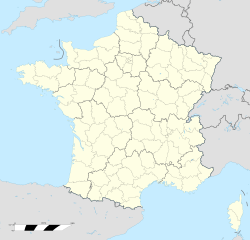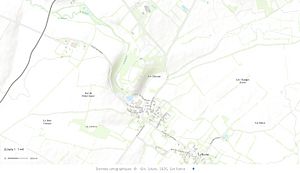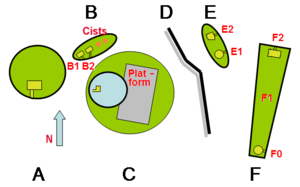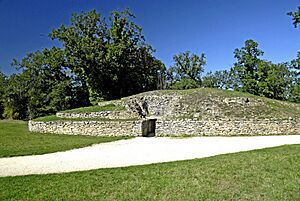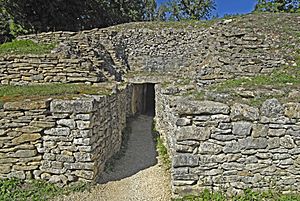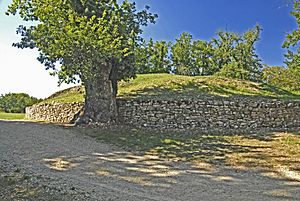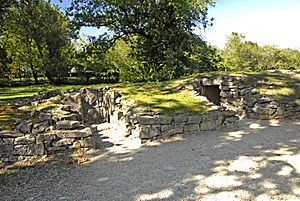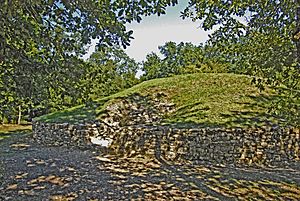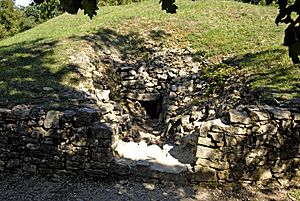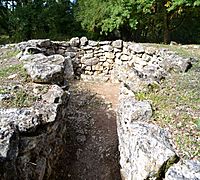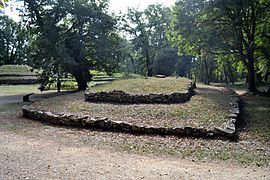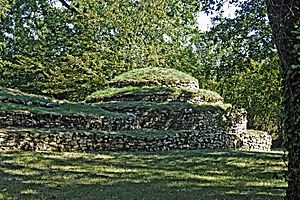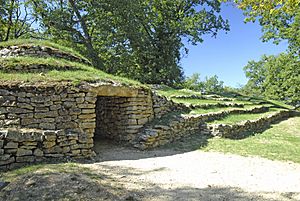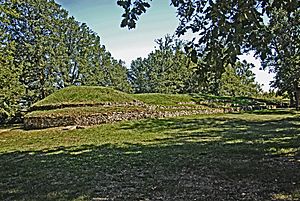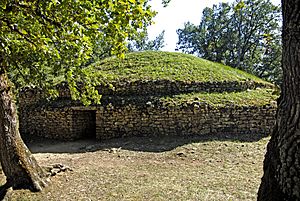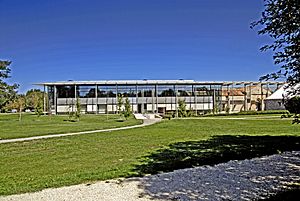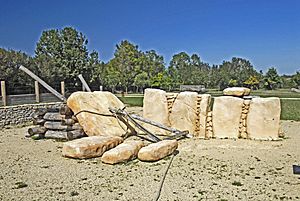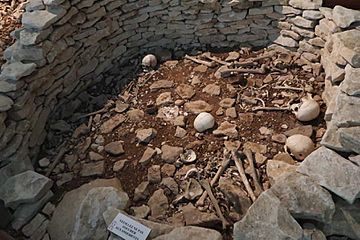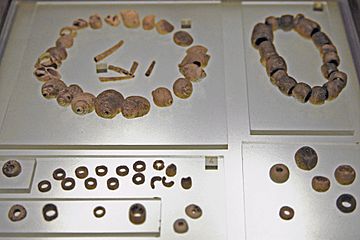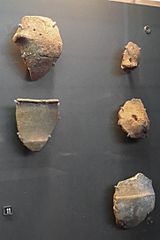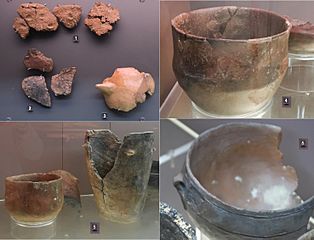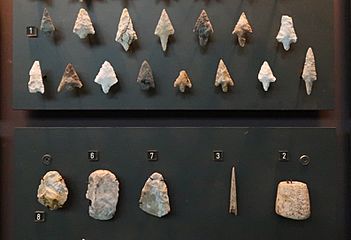Tumulus of Bougon facts for kids
|
Les Chirons
|
|
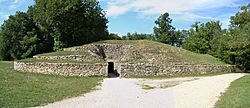
Tumulus A, necropolis of Les Chirons Bougon, Deux-Sèvres, France
|
|
| Location | valley of the River Bougon |
|---|---|
| Region | Nouvelle-Aquitaine, France |
| Coordinates | 46°22′24″N 0°03′59″W / 46.3732°N 0.0664°W |
| Altitude | 95 m (312 ft) |
| Type | Angoumoisin Tumulus |
| History | |
| Material | Limestone |
| Periods | Neolithic |
| Cultures | Chasséen |
| Site notes | |
| Archaeologists | 1840 : Charles Arnault 1968 : Claude Burnez 1972 to 1987 : Jean-Pierre Mohen, Chris Scarre |
| Public access | yes (guided tour only) |
|
Monument historique
|
|
| Designated | 1960 |
The Tumulus of Bougon is a very old burial site in France. It is also called the Necropolis of Bougon. A "tumulus" is a mound of earth or stones built over a grave. This site has five large mounds from the Neolithic period, which was the New Stone Age. These mounds are located in Bougon, a town in Nouvelle-Aquitaine, France.
People first found these amazing mounds in 1840. Scientists were very excited about them! To keep them safe, the local government bought the land in 1873. More digging, called excavations, started again in the late 1960s. The oldest parts of this ancient place, called E1 and F0, were built around 4800 BC. That's about 6,800 years ago!
Contents
Exploring the Ancient Site
The Bougon site is on a flat area made of limestone, next to the Bougon River. This area was once known as "Les Chirons."
Tumulus A: The Big Mound
This mound was built in the early 4th millennium BC (around 4000-3000 BC). It is 42 meters wide and 5 meters tall. Inside, there is a large rectangular room, about 7.8 by 5 meters, and 2.25 meters high. A passage leads into this room.
The walls of the room are made of huge, shaped stones called orthostats. Smaller stones fill the gaps between them. A giant stone slab, weighing 90 tons, covers the room like a roof! Two tall stone pillars hold up this roof and divide the room. You can even see ammonite fossils, which are ancient sea creatures, in these pillars.
When archaeologists dug here in 1840, they found about 200 skeletons! They were in three layers, separated by stone slabs. Along with the bones, they found pottery, beads, pierced teeth, seashell chains, and stone tools. One special tool was a mace made of diorite stone.
Later digs showed that the tomb was closed soon after it was built. A big stone blocked the passage. Near this stone, they found the skull of a man who had three trepanations during his life. This means holes were made in his skull, possibly for medical reasons. Pottery found outside suggests that people held ceremonies there even after the tomb was closed. About 1,000 years later, people from a different culture used the monument again for more burials.
Tumulus B: The Long Mound
Tumulus B is a long mound, 36 meters long and 8 meters wide. It has four burial rooms. Two are very small stone boxes called cists, with no way to get inside. The western part of the mound has two larger rectangular rooms, each with a passage from the south.
Chamber B1: The Small Stone Room
Chamber B1 is a small square room made of single stone slabs. A 2.2-meter passage leads to a room about 2 by 1.5 meters. It was built simply with four wall slabs and one roof slab. One wall slab has a hook carved into it. Not many old items were found here, probably because it was cleaned out and reused later.
Chamber B2: Unique Burials
When this chamber was dug up, archaeologists found something unusual. About ten skullcaps (the top part of skulls) were placed upside down in two rows. They were found with several long bones.
Cists: Empty Stone Boxes
The small stone boxes (cists) in the eastern part of the mound were found in 1978. They were in the middle of the mound and built from small stones. Both were empty, but they might be connected to a large pile of broken pottery pieces found nearby.
Tumulus C: The Complex Circle
This circular mound is made of earth. It is 57 meters wide and 5 meters tall. It's a complex structure because it was built in several stages. The mound covers two older monuments: a rectangular platform and a smaller circular mound.
Earlier Mound: The First Circle
The older mound was 24 meters wide and 4 meters tall. It had a small room (2 by 1.45 meters) that was not in the center. You could get to it from the west through a passage. Six stone slabs formed its floor. Inside, archaeologists found four skeletons, including an old woman, along with pottery and flint tools.
Platform: A Mystery Area
Next to the older mound, on its east side, was a large platform, 20 by 40 meters. This might have been a place where bodies were left to decay before burial. In front of each of its three tall walls, a double burial of an adult and a child was found.
Structure D: The Dividing Wall
A 35-meter-long and 2-meter-tall wall made of dry stone divides the Bougon site into two parts. It separates Tumuli E and F from the other mounds. This wall is very old, from the Neolithic period, and is unique among ancient stone monuments in France.
Tumulus E: Two Chambers in One
This mound has two levels and is 22 meters long and 10 meters wide. It has two chambers, both accessed from the east. Originally, these chambers were in separate circular mounds.
- Tumulus E
Chamber E1: The Round Room
The southern chamber is 3 meters wide and has a circular, tholos-like shape. This means its walls curve inward to form a dome. Its base is built with 11 large stone blocks. Archaeologists found five or six skeletons here, along with pottery, bone tools, and stone tools. These items date back to between 4000 and 3500 BC, making it one of the oldest stone tomb structures in Central France.
Chamber E2: The Northern Room
E2, in the northern part of Tumulus E, is almost square with one rounded side. It might have been changed around 2500 BC, long after it was first built. Items found here included arrowheads, knives, and scrapers. They also found rough, round-bottomed pottery.
Tumulus F: The Biggest Monument
This mound is shaped like a trapezoid, 72 meters long and 12 to 16 meters wide. It is the largest monument at Bougon. Its western end was next to a pit that was filled in long ago. This pit was where the earth for the mound (which was originally 3 meters high) came from. The mound has two chambers (F0 and F2), one at each end. Between them are seven other structures (F1) that do not have burial chambers.
F0: The Oldest Part
This monument was built in the first half of the 5th millennium BC (around 5000-4500 BC) and reused later. It is one of the oldest examples of large ancient buildings in Atlantic France. In 1977, archaeologists found a steep, round mound containing a circular structure 2.5 meters wide. It has a triple stone facade and a corbelled roof, where stones are laid in layers, each sticking out a little further than the one below, until they meet at the top.
This tomb, from about 4700 BC, held the bones of about ten people, half of them children. There were not many artifacts, mainly two pots, six bone chisels, and some flint tools.
F1: Stabilizing Structures
The F1 area has no burial chambers. It has a series of structures, some rectangular, that helped keep the large monument stable. The walls separating these structures go down to the original ground level where the tomb was built. The earth of the mound here contained the remains of a man, a woman, and a child.
F2: The Northern Chamber
This chamber, built in the early 4th millennium BC, is at the north end of Tumulus F. It was also reused later. The chamber is about 5 by 2 meters and is covered by a huge 32-ton stone slab. This stone came from about 4 kilometers away! Only a few items were found here, including pottery pieces, some unusual beads, and flint tools.
How Bougon Changed Over Time
The way the buildings at Bougon were made changed over about 1,000 years. There were three main phases:
- First, people built round or oval mounds with chambers that had corbelled roofs.
- Next, they built long mounds with small rectangular stone chambers.
- Finally, they built large rectangular stone chambers.
The Bougon Museum
The Bougon Museum opened in 1993. It's a modern building that includes an old farmhouse. The museum teaches visitors about prehistory, especially the Neolithic period.
Inside, you can see items found at the Bougon site. There are also cool replicas, like a room from an ancient Neolithic village called Çatalhöyük in Turkey. You can also see copies of the amazing art from the passage tomb of Gavrinis in Brittany.
Outside the museum, there's an area with displays about experimental archaeology. This means they try to recreate how ancient people did things. For example, you can see how they might have moved and built huge stone monuments like the ones at Bougon!
- Museum rooms: Bougon necropolis and Neolithic sites of Deux-Sèvres
-
Skull having been trephined three times, corridor of tumulus A, upper level, 4th millennium.
-
Perforated shells, limestone and variscite pearls. Tumulus A, upper level, 4th millennium.
-
Shards, Middle Neolithic. Tumulus A dolmen II. Set of Atlantic Chasséen type ceramics.
-
Ceramics, Bougon necropolis. Early and middle Neolithic, 5th millennium: 1, 2, 3. Late Neolithic, late 4th millennium: 4, 5, 6.
See also
- Necropolis of Monpalais (in french)
- Tumulus du Péré (in french)
- List of megaliths (in french) in Deux-Sèvres
- List of oldest known surviving buildings
- Megaliths
- Barnenez


